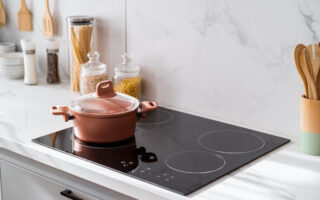
Clean new and black induction stove with control panel near marble countertop on white kitchen. Metal saucepan and jars with products on cooking surface. Cookery and homemade food concept
Have you ever used something called an induction cooking range? If you haven’t, it might be a good idea to try one out. Then you’ll see how these alternatives to electric and gas stoves work.
In some places, you can simply check one out at your local library.
Range Tops from the Library System
Coverage of the Allegheny library system in Pittsburgh shows that a branch there has two of these systems in the form of small, portable ranges, available for borrowing. Locals can check one out with a library card. For example, if you want extra cook space, that’s convenient. Or someone can sign one out for a family reunion or public event.
The library’s Program and Volunteer Coordinator, Bill Mocker, talks about the sustainability of induction ranges. Later in the piece, Flora Cardoni, the Deputy Director of PennEnvironment, mentions their effectiveness in lowering the frequency of asthma cases in children.
“Stovetops that run on gas have also been shown to dramatically increase indoor air pollution,” Cardoni says. “A recent study found that over 12% of childhood asthma cases could be attributed to indoor gas stove use, and could be prevented by using an induction or electric stove instead.”
In general, these stoves are better for human health and the environment. They limit energy use, and that leads to some kinds of savings in terms of air pollution. Scientists have found that one of these ranges wastes far less heat, with up to 85–90% efficiency, compared to gas, which has corollary estimates of 35–40%, or standard electric coil stoves with around 70%. Then there’s the carbon dioxide, methane, nitrogen dioxide and particulate matter typically given off by a gas stove.
It’s also more targeted cooking and heating: because induction heats only the cookware, less heat escapes into the kitchen. This reduces energy needed for air conditioning in hot kitchens.
How the Induction Range Works
The induction cook top heats cookware with electromagnetic fields characterized as “non-ionizing radiation” to prove that they’re not carcinogens. Alternating electric current runs through a copper coil below the cook top. A magnetic field moves through the glass top, and if cookware is made of a ferromagnetic material like cast iron or some stainless steel, the magnetic field excites the metal’s electrons. This causes something called “eddy currents” inside of the metal. That’s how the pan or cookware gets heated.
The heat only heats the pan, not the cook top. It’s a really neat change from traditional cooking systems, and something that many home cooks would like to try for themselves. If you live in the Pittsburgh area, your local library will help.
Technology to the Rescue
We’re seeing a lot of this kind of innovation now, as scientific research explodes in the age of AI. Now there are finally more sustainable ways for people to cook their food. It wasn’t too long ago that many of the poor societies commonly practiced burning wood, or even animal waste, to get the energy to cook their food.
Now we’re replacing carbon-intensive combustion processes with electricity and EMF fields that can do this work in a cleaner way.
The induction cook top can be convenient, too.
“Many professional chefs have started using induction cooktops in their restaurants and home kitchens,” writes Miriam Aczel, a postdoctoral scholar, at EcoKitchens. “Induction cook tops are rapidly gaining in popularity as they are energy-efficient, easy to clean, and heat and cool quickly. Many chefs have reported that they love induction cooking because of its quick heating ability and precise temperature control.”
Why It’s Important
Air pollution is something that compounds. Fossil fuel burning puts more of these elements into the environment, and pollutes the air in a given community.
But it’s also possible to protect yourself and the health of your family with air purifiers that cleanse the air inside of your home, where you spend so much time day to day.
That means figuring out what’s contaminating your indoor air, and taking steps to remediate. For this task, you can use an air monitor that will provide a reading of various contaminants.
Then you choose the technology that you need in an air purifier. For example, a modern HEPA filter is highly effective against small particles, and is a standard part of many modern air purifier models.
You can also get activated carbon that catches certain kinds of pollution in its small pores.
There are other kinds of new technology, too, from ultraviolet light treatments, to models that actually emit helpful probiotics as a way to counter the existence of pathogens in indoor air.
Some of these things involved during the coronavirus pandemic – others are a response to particulate, resulting from wildfires, vehicles and industrial pollution.
Take a minute to think about equipping your home with these modern health-saving appliances. US Air Purifiers LLC can help with design questions and more – we can help you to find the best model for your needs. Become more confident about your health and your family’s health in your home.